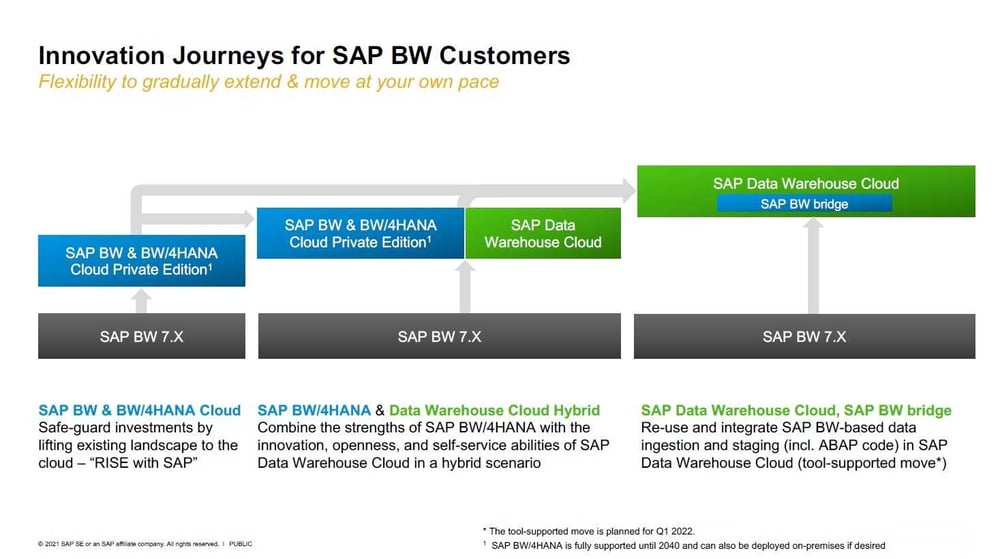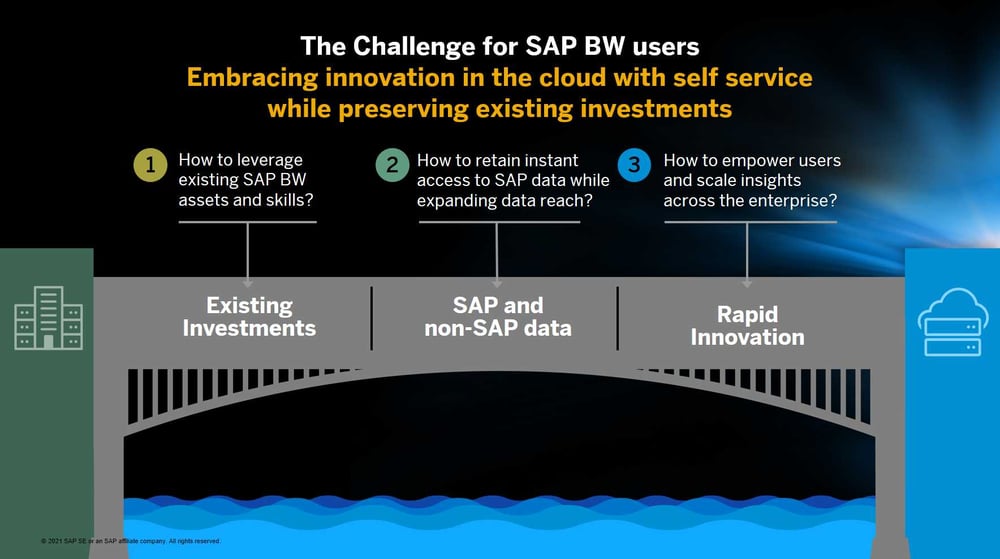Making your own data warehouse ready for the future is an important part of the digital transformation of companies. Crucial aspects in this context are greater agility and flexibility, democratized data use with the help of self-services for the business department, and the seamless integration of external data sources. In addition, companies ideally want to gain the benefits of cloud data warehousing without losing investments they made in their on-premise systems.
Make your data warehouse ready for the future
To-dos regarding data utilization
In the past, most companies established a centralized data platform and used the existing data primarily for reporting. In the digital age, data volumes are growing rapidly, and the options for how to use the data have also increased significantly. In addition to reporting, the disciplines of analytics and corporate planning are gaining in importance. To take advantage of the new opportunities, external systems must be seamlessly connected to the SAP landscape. At the same time, business and IT must be enabled to interact with each other on a common platform.
The list of topics that companies should put on their agendas with a view to state-of-the-art data management and efficient data utilization is correspondingly long: Data silos must be broken down in order to pull together the data available in various systems on a central platform. Data must penetrate deeper into the business departments so that users can, for example, carry out modeling themselves, thereby relieving the burden on IT. To reconcile greater flexibility and investment security, a step-by-step move of data warehousing to the cloud is a good idea. Hybrid scenarios with a combination of on-premise and cloud solutions offer the opportunity to continue using existing assets and to develop new use cases.

Source: SAP SE
Unified Data Analytics
SAP offers a diverse cloud-based portfolio for the area of data and analytics and summarizes the solutions under the keyword “Unified Data Analytics”. It is intended to offer companies the right cloud application for every requirement. SAP Analytics Cloud, for example, serves as an analysis tool for reporting and planning, while SAP Data Warehouse Cloud (DWC) provides self-services for the business department. SAP Data Intelligence Cloud ensures that data is available in the required quality and is always accessible exactly where it is needed. SAP HANA Cloud completes the portfolio as a database-as-a-service (DBaaS) for integrating data from across the enterprise.
With these applications, companies are able to connect different source systems, each with its own independent data models, integrate and orchestrate structured and unstructured data, and semantically enrich the data. The Space concept of SAP Data Warehouse Cloud creates delimited areas in which the departments can work with the data relevant to them. But SAP DWC naturally also offers the possibility of sharing the data and the associated knowledge throughout the entire company.
SAP BW/4HANA is still relevant
Despite its strategic focus on data warehousing in the cloud, SAP is not completely abandoning on-premise. Maintenance for SAP BW/4HANA is still guaranteed until 2040. In fact, moving from SAP BW 7.x to SAP BW/4HANA can be a useful intermediate step for companies on their way to SAP Data Warehouse Cloud. Hybrid scenarios combine the use of SAP BW/4HANA and SAP DWC and benefit from the advantages of both approaches. SAP BW Bridge preserves the investments made in SAP BW and at the same time offers the opportunity to take advantage of the high pace of innovation in the cloud. By allowing existing logics to continue to be used, SAP BW Bridge creates valuable consistency from a business perspective. From Q1/2022, SAP will provide supporting tools for the gradual move to the cloud using SAP BW Bridge.

Source: SAP SE
Practical insights from Fresenius Kabi ...
Fresenius Kabi and Piller Blowers & Compressors are currently realigning their data warehouse strategy and have hybrid scenarios in place. Fresenius Kabi is a global healthcare company that provides drugs and medical devices for infusion, transfusion and clinical nutrition. Due to strict regulations in the medical industry, moving its data warehouse completely to the cloud is not yet an option for the company. Currently, Fresenius Kabi is using SAP BW 7.5, while Analysis for Office and SAP Analytics Cloud are used for reporting. But SAP Data Warehouse Cloud also provides valuable services, for example, when it comes to integrating SAP and non-SAP data or being able to use data via streaming without time delay. In addition, Fresenius Kabi benefits from more extensive options for data modeling compared to SAC, from the reusability of investments made in SAP BW, and from being able to map new use cases and changing requirements of the business department more quickly.
... and Piller Blowers & Compressors
Piller, a medium-sized manufacturer of special-purpose machines, pursues a consistent cloud strategy, but had initially decided to implement SAP BW/4HANA in 2018 – supported by implementation partner IBsolution, with whom Piller has been working successfully for many years, not only in the BW area, but also on the topic of customer experience. Now the company, which manufactures industrial fans, wants to take the next step into the cloud. That’s why Piller is participating in SAP’s early adopter program for SAP BW Bridge, which started in November 2021. There are several expectations associated with SAP BW Bridge at Piller: Reduction of administrative effort, better integration of the various on-premise and cloud systems in the company, higher speed of innovation. In the long term, SAP Data Warehouse Cloud will act as a consolidation layer for all available data.
Particularly relevant for Piller is the question of whether all analyses and evaluations from SAP BW/4HANA can really be mapped in SAP Data Warehouse Cloud. The experiences with SAP BW Bridge and SAP DWC so far have been positive. The fast and simple provisioning and the high performance have been particularly convincing. After evaluating the first use case, one thing is clear: Piller considers SAP BW Bridge to be a helpful tool for continuing the gradual migration of the data warehouse to the cloud.
We answer the most important questions about SAP BW Bridge
![IBacademy_Logo_blau[496] IBacademy_Logo_blau[496]](https://www.ibsolution.com/hs-fs/hubfs/IBacademy_Logo_blau%5B496%5D.jpg?width=200&name=IBacademy_Logo_blau%5B496%5D.jpg)




